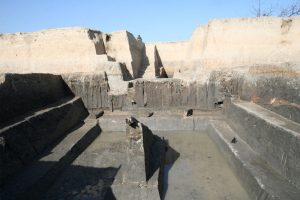
Researchers found a series of high and low dams, and levees built 5000 years ago in the ancient city of Liangzhu, making it one of the world’s largest and oldest-known hydraulic engineering systems. Photo courtesy of the Zhejiang Provincial Institute of Cultural Relics and Archaeology.
It was as true 5000 years ago as it is today: losing all your food in a flood is a major disappointment.
For the people living in the Yangtze River Delta along the eastern coast of present-day China, it was also the impetus behind one of the oldest and largest formal water management systems in the world, according to Yijie Zhuang, one of the University College London researchers who helped unearth the system.
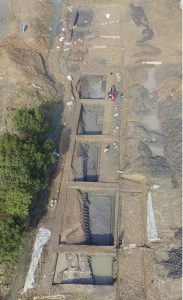
The canal of Zhongjiagang helped control the flow of water inside and outside the area of the ancient city of Liangzhu. Photo courtesy of the Zhejiang Provincial Institute of Cultural Relics and Archaeology.
The massive hydraulic system was built to control the flow of water inside and outside the area that became the ancient city of Liangzhu. Local inhabitants seemed to have grown weary of the flooding that periodically destroyed their rice crops.
“The whole region is low-lying, with most places only [3 meters] 10 feet higher than sea level,” Zhuang said. “It is also a monsoon-influenced region receiving concentrated precipitation in the summer. So [it is] very vulnerable to floods.”
Rather than abandon the fertile region, ancient engineers set to work digging and moving earth to change the landscape, which spans nearly 100 km2 (40 mi2), Zhuang said.
A series of gates was created to control the movement of water through a system of canals, dams, levees, and ditches.
Creating a hydraulic engineering marvel
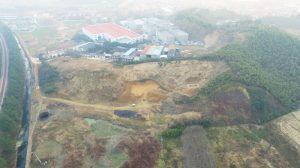
An aerial photo taken during the excavation shows the project and the area of the Laohuling dam. Photo courtesy of the Zhejiang Provincial Institute of Cultural Relics and Archaeology.
Researchers from several universities and research organizations spent 4 years surveying and excavating the site to uncover the hydraulic system and city’s remains.
“The canals and rivers in and outside the Liangzhu City measure around [30 km] 18.6 miles in total,” Zhuang said. “The earth used in the construction mainly came from two sources: grayish clay from the river channels and yellowish clay from the nearby geologies, which was transported to the construction sites.”
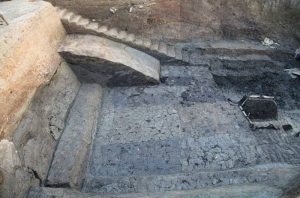
A dam excavated at the site of the Mojiaoshan palace in the city of Liangzhu has a surface composed entirely of sand bags. Photo courtesy of the Zhejiang Provincial Institute of Cultural Relics and Archaeology.
Boats are thought to have transported people and materials by canals during construction. “No evidence of animal traction or wheel transportation tools have been found in Liangzhu,” Zhuang said. “We surmise that water transportation was the most efficient way of transporting material.”
The feat of hydraulic engineering not only prevented flooding; it allowed residents to irrigate crops during droughts using rainwater stored in large reservoirs, Zhuang said. It also facilitated construction of the large-scale urban settlement that became the city of Liangzhu.
Studying expansive system provides insight into ancient society
But Liangzhu’s water management system wasn’t built in a day. According to the paper, “Earliest hydraulic enterprise in China, 5100 years ago,” published in the Proceedings of the National Academy of Sciences, it took approximately 3000 people working 8 years to build just one of the system’s larger dams. This project alone involved moving approximately 283,000 m3 (10 million ft3) of earth.
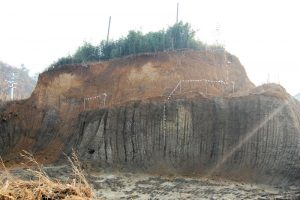
Thousands of workers spent more than a decade to move more than 283,000 m3 (10 million ft3) of earth to build the dams, canals and other elements of the ancient hydraulic system that include the Ganggongling dam. Photo courtesy of the Zhejiang Provincial Institute of Cultural Relics and Archaeology.
The scope of the system suggests an enormous collective undertaking, offering researchers insights into how the economy and society of Liangzhu functioned and developed. Drivers for the city’s long-term success included an ability to expand rice production after completing the hydraulic system, Zhuang said.
“The intensification of rice farming can be seen at the excavation of the Maoshan rice paddy field sites,” said Zhuang. “We don’t have direct evidence yet for the irrigation function of the hydraulic system, but it must have been one of the important functions of the dams.”
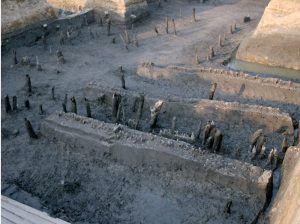
Wood stakes at the bottom of the Bianjiashan pier were preserved portions of the ancient hydraulic system. Photo courtesy of the Zhejiang Provincial Institute of Cultural Relics and Archaeology.
Engineers from two Chinese universities continue to study the function and design of the system.
For Zhuang, the project represents something more awe-inspiring. “The most amazing thing about this is its early date and sheer scale,” he said. “(It) revolutionized the hydraulic history of China.”
— Mary Bufe, WEF Highlights
Follow Water History Articles in WEF Highlights
|








May 24, 2018
Featured